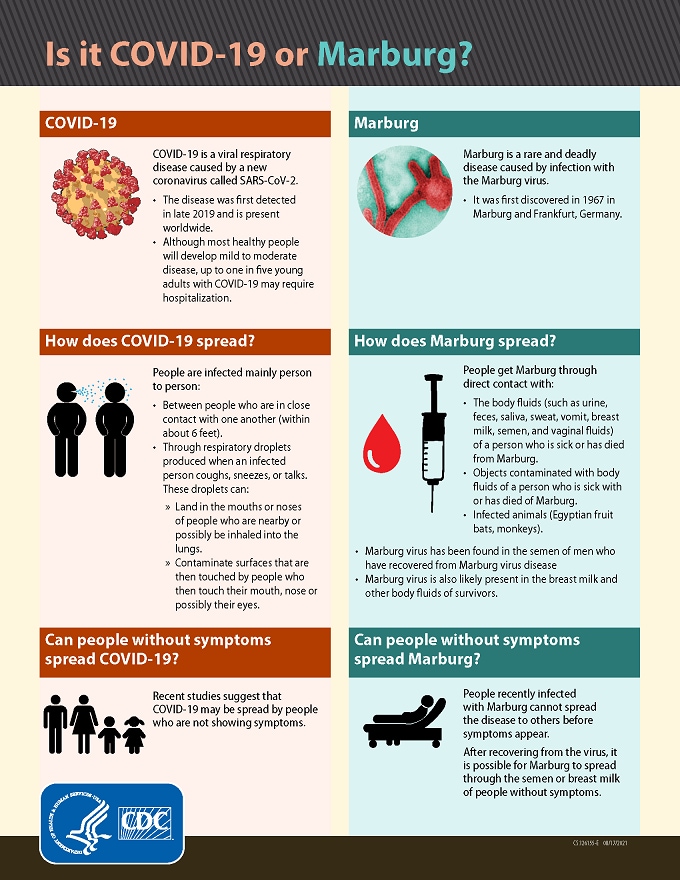Additional languages
Text equivalent
COVID-19
COVID-19 is a viral respiratory disease caused by a new coronavirus called SARS-CoV-2.
- The disease was first detected in late 2019 and is present worldwide.
- Although most healthy people will develop mild to moderate disease, up to one in five young adults with COVID-19 may require hospitalization.
Marburg
Marburg is a rare and deadly disease caused by infection with the Marburg virus.
- It was first discovered in 1967 in Marburg and Frankfurt, Germany.
How does COVID-19 spread?
People are infected mainly person to person:
- Between people who are in close contact with one another (within about 6 feet).
- Through respiratory droplets produced when an infected person coughs, sneezes, or talks. These droplets can:
- Land in the mouths or noses of people who are nearby or possibly be inhaled into the lungs.
- Contaminate surfaces that are then touched by people who then touch their mouth, nose or possibly their eyes.
- Contaminate surfaces that are then touched by people who then touch their mouth, nose or possibly their eyes.
How does Marburg spread?
People get Marburg through direct contact with:
- The body fluids (such as urine, feces, saliva, sweat, vomit, breast milk, semen, and vaginal fluids) of a person who is sick or has died from Marburg.
- Objects contaminated with body fluids of a person who is sick with or has died of Marburg.
- Infected animals (Egyptian fruit bats, monkeys).
- Marburg virus has been found in the semen of men who have recovered from Marburg virus disease.
- Marburg virus is also likely present in the breast milk and other body fluids of survivors.
Can people without symptoms spread COVID-19?
Recent studies suggest that COVID-19 may be spread by people who are not showing symptoms.
Can people without symptoms spread Marburg?
People recently infected with Marburg cannot spread the disease to others before symptoms appear.
After recovering from the virus, it is possible for Marburg to spread through the semen or breast milk of people without symptoms.
Signs and symptoms of COVID-19
The signs and symptoms of COVID can appear 2-14 days after exposure. In some people, symptoms of COVID-19 can worsen after the first week of illness.
Most Common
- Fever
- Chills
- Fatigue
- Cough
- Shortness of breath
- Muscle pains
Additional Symptoms
- Headache
- Sore throat
- New loss of taste or smell
- Runny nose
- Bloody sputum
- Vomiting and diarrhea
Signs and symptoms of Marburg
Most Common
- Fever
- Aches and pains, such as severe headache, muscle and joint pain, and stomach pain
- Weakness and fatigue
- Diarrhea and vomiting
Additional Symptoms
- Unexplained hemorrhaging (bleeding or bruising)
- Red eyes
- Skin rash
- Hiccups (late stage)
Who is at high risk for becoming infected with COVID-19?
Healthcare providers and family members taking careof patients with COVID-19 are more frequently exposed.
- Residents of skilled nursing facilities and communal living centers who have frequent contact with others.
Who is at high risk for becoming infected with Marburg?
- Health workers who do not use proper infection control while caring for Marburg patients, and family and friends in close contact with Marburg patients.
- People who have close contact with bats and or their urine/droppings, or spend time where bats congregate (such as caves, mines, abandoned buildings).
- Marburg poses little risk to travelers or the general public who have not cared for or been in close contact (within 3 feet) with someone sick with Marburg.
Who is at risk of severe illness from COVID-19?
Older adults and people of all ages who have chronic underlying medical conditions, like heart or lung disease or diabetes, seem to be at higher risk for developing more serious complications and dying from COVID-19.
Who is at risk of severe illness from Marburg?
Pregnant women, children, and those who are late in the course of illness are at higher risk of dying from Marburg.

